Editorial
Hello all from your semi-retired Editor! Yes, as of late September, I've given up the daily grind of research so I can devote my remaining good health to making models, chips, mistakes, puttering about in The Library, and (according to Ruthie) indulging in a series of cruises to exotic lands. On hearing the last, I promptly accepted a part time research job back at the university  , hence the "semi-retirement". I like to think that I left on a high though. My iPhone app for identifying and reporting algal bloom species was accepted by Apple and is now a free download (see the ABRA web page). A paper on its design was accepted for the 2011 Australasian eResearch conference, so I'm calling my swan-song performance a resounding success.
, hence the "semi-retirement". I like to think that I left on a high though. My iPhone app for identifying and reporting algal bloom species was accepted by Apple and is now a free download (see the ABRA web page). A paper on its design was accepted for the 2011 Australasian eResearch conference, so I'm calling my swan-song performance a resounding success.
Building that iPhone app, and learning the languages and tools associated with all things Apple had turned into an all-consuming monster during the past nine months, leaving neither time nor energy for much else. That should now change (though I've an idea for an iPad app of my own in the home entertainment/automation field). First job will be to spray the Bendix racer C/L model that's sitting on the workbench (after removing the cobwebs) and making a couple of tools I've been promising myself for ages. In fact, one of these got completed just this week, as you can read in this month's Tech-Tip. The October issue may be short on news items, but we've got lots of new material and updates to favorites like the Watzits, and the Engine Gallery. Hope you enjoy them and we'll see what wonders next month brings... then again I may just sleep in for a month; I think I've earned it!
A Very Innovative Watzit
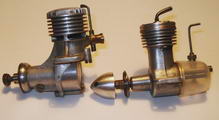
Photos of a very innovative and incomplete Watzit arrived from a reader in Sweden this month which we are pleased to share with you. We were unable to help the owner identify the engine. Neither were we able to confirm nor deny the possibility that the engine had been designed and partially built by the well known scale contestant, Mr Kurt Lennå. What we were able to do was generate a chain of emails praising and criticizing the engine's many odd features; turn to Page 7 of the Watzits to read what we thought regarding this little "beauty".
An Important Patent
Readers of the Aeromodeller of old may remember an occasional series they ran called Important Patents. This covered such things as Jim Walker's C/L bellcrank patent, and Ray Arden's glow plug. As a young lad, I was always amazed how anyone could make sense of these things. The drawings bore very little resemblance to what I knew to be reality and the text was somewhat impenetrable . Now being older and wiser, or at least more cynical, I know this is due to the language of patents where the author—or more importantly, his patent atourney—discloses as little as possible while "protecting" the broadest possible interpretations against future exploitation in the hopes of profit.

As an example, here's one sent to me by David Burke, Grand Fromage at Adelaide Aeromotive, makers of Taipan reproductions. The patent was filed in 1960 by J Garofali, whom readers may recognize as Mr Super Tigre, and deals with a form of transfer port cutting to provide a loop-flow scavenge pattern without the use of a piston baffle (you could argue it's cross-flow, but with the transfer port opposite the exhaust). Notice that the patent date is 1962 indicating that the process took two years to cover five countries. David believes that Gordon Burford, designer and builder of the Australian Taipan and Glow Chief range of engines was toying with this style of porting, but gave it up when made aware of the Garofali patent. Click here for the full text of US patent #3038457 as a pdf.
Austral Tornado

David Owen has found another Australian rarity for us: the Austral Tornado. This was a pre-WWII product of a company which also produced stick and tissue rubber-powered model kits and accessories for modellers. There must have been warehouses full of these as I remember building one or two (or at least, trying to build them) somewhat after WWII. The engine is another that we know relatively little about and so would welcome contact with anyone able to provide any authoritative facts. What we do know you can read on the new Austral Tornado page and thanks to Dave for collecting the information and photos from diverse sources.
A Rear Induction Ollie Cub
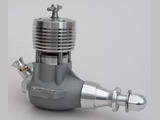
Should that be "Olie" or "Ollie"? There's only one L in Oliver, but the familiar format looks strange without two of them... oh well, I'm sure some authority will be able to set us straight on the approved spelling. In the mean time, the little beauty in the photo is a one-off rear drum induction version made by Jan Huning (UK). Jan started with a genuine, unmachined Mk 4 Cub crankacse and worked outwards from there, using our page on a Schnurele RI Cub page for inspiration. More pictures of the engine in assembled and parts form, together with some machining shots showing how the backplate was done can be seen on Page 17 of the Engine Gallery.
New Books and Magazines This Month
In his review of the Austral Tornado, David Owen mentions it's similarity to the venerable GHQ (of dubious report) and its rather better regarded predecessor, the Loutrel. This is an engine I don't have, but have always sort-of wanted (meaning I've never quite had the energy to chase one down, and have been put off by the asking price on the odd occasion when one pops up on eBay). The desire stems from two sources. First, many say the GHQ, like the Deezil, would not run without either luck, or serious modification, so the inherent challenge appeals to me. Second, I happen to have some rather detailed drawings of the engine in an old 1944 book by one Bernard B Winston. A quick check on ABE Books shows three copies available, so what better accompaniment to David's piece than a review of the book?
Adrian Duncan noted in his analysis of America's Hobby Center that the Winston brother were pioneers of mail order marketing, and despite what AHC may have become in its final years, for a long time, it provided value to many young modellers, this one included. One feature of AHC's marketing was little booklets on aspects of the hobby, often included as a bonus on "package deals". These were produced "in-house" by AHC's Winston Publishers Division and frequently drew heavily on manufacturers' material with minimal authoring. That's not to say they were "rubbish"—far from it in fact—however it is obvious that they would have cost rather little to produce and must have represented a decent revenue stream to AHC.

AHC's Model Gas Engine Handbook, by Bernard B Winston, Winston Publishers, USA, (no ISBN) first appeared in 1944. My copy lists six printings totaling 38,000 copies; there may have been more. The book is softbound in a 7-5/8 x 5-1/2" format with 150 pages of rather cheap paper. While much of the material comes from engine manufacturers of the period, all has been re-typeset in a consistent font and style, so this is not just a compilation of other material. The cover page subtitles the book, A complete manual of the Theory and Practice of Model Gas Engine operation and begins with what the author calls a "Preface and Apology", stating that "Since this book is not encyclopedic, many phases may have been touched on too lightly—or indeed, not at all." So much for "complete", and great getoutagaol clause, Bernie.
The book is divided into fifteen chapters, including theory, ignition-wiring diagrams, mathematics, "don'ts", specifications of principal engines (reproduced from Model Aeroplane News, with permission), blueprints for building two model gas engines, and instruction sheets for selected principal engines. As such books go, it is actually quite good and reasonably comprehensive. The chapter providing instruction sheets for "principal engines" will be of special interest to collectors who may have acquired an example of a particular type and wonder what that maker may have had to say about its operation. A quick count says 38 types are covered with detail varying between a couple of paragraphs to several pages with photos and drawings—inshort, whatever the manufacturer provided. All of the popular types are there, including the Brown Jr, the Atom, Ohlsson, OK (single and twin), Elf, (single, twin, and four-cylinder), plus many of the more exotic types such as the Comet, Megow 199, G9, and Silver King (that one I had to look up in the AMEE). The Feeney four-stroke even gets a page.
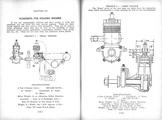
The section on Blueprints for Building Engines is of special interest. Well dimensioned drawings for two engines are provided. The first is called the "REAL" engine. It's a two-stroke sideport with a bore of 3/4" and a stroke of 3/4" for a displacement of .331 cuin, featuring a full crankshaft with rear-mounted timer, cast-iron liner and piston (baffled), and a head with a built-in spark plug. According to the late Hamilton Upshur, the "REAL" first appeared in 1932 in finished or kit form, marketed by one Louis P Loutrel, of Brooklin, New York.
The second "project" is called the "AERO" engine and is quite obviously a Loutrel/GHQ. Again according to Upshur, writing in SIC, issue #76, this is a slightly enlarged version of the "REAL", with a 15/16" bore and the timer moved to the front, thus simplifying the crankshaft. This engine was sold briefly in 1933/34 as the "LOUTREL AERO" and is basically the GHQ of later years with sand cast parts, and good quality machining. The drawings in Bernie's Handbook provide sufficient dimensions for an enterprising model engineer to make the required patterns for sand casting. Machining instructions are provided, though they give terseness a new meaning, for example:
4. REAR HALF CRANKCASE. Chuck, turn to size, drill bolt holes.
Given that the case is split vertically on the centerline and that the plans clearly show a register which keys the two halves together, one is left thinking that perhaps some important steps have been left out there. So while not for the total beginner, an experienced model engineer would have no particular problem just working from the plans.
The chapter titled Don'ts list seventy-two (72) numbered items. I rather like #44: DON'T take the advice of "experts" as being final. Write the factory for information. Most "experts" do not fully understand the two-cycle principle. That's every bit as true today as it was in 1944, possibly even more so!
Bernie's Gas Book covers only ignition engines, understandable given the period since the glow-plug had yet to be perfected (it had been "invented"), and diesels were just beginning to move out of Europe. So the material is dated and rather scatter-shot. The section on instructions will interest collectors, and the section on building may spark the odd model engineer to action. GHQ owners get a double dose with instructions for both the kit and factory-built versions, plus the plans required to blueprint their engine and maybe get it to actually run. I rather like the book more for what it provides today than what it would have provided back when it first appeared; Four Stars  .
.
Aside: while checking spelling, I noticed that Fisher uses "Lautrel" in the text (p26), and "Lauterel" in the index. So Clanford is not the only one capable of inaccuracies and mistakes!
Engine Of The Month: The Fuji Story
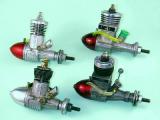
Our engine this month is another of Adrian's highly researched, multi-part, Japanese model engine maker sagas. This time, he looks into one of the brands which achieved some recognition in the west, namely the engines made by the Fuji Tokushu Kiki company. This month we have two parts, The first describes the Historical Background of the company. The second delves into what is known and can be reasonably deduced regarding Fuji's Corporate History. We'll give you a break from things Fuji next month so those without a fascination for oriental engines get a turn at bat. However, be assured, Adrian has more chapters ready, or near completion which cover all of Fuji's numerous and inexpensive but nicely made products.
Tech Tip of the Month
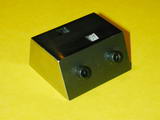
Last month, I showed a teaser shot of a project under way, promising more details when it was completed. The mystery device (seen again here) is a jig for sharpening small twist drills. How small you ask? Very small; we are talking drills in the range #38 to #80—that's about 0.10" to 0.01", or 2.5mm to 0.35mm if you are metricated. Now the big question: does it work? I'm pleased to say, yes it does—quite well in fact, though like any tool, there is a learning curve and there are limitations, though they are resident in the eyesight of the user rather than the device itself. To read more about the device, why I (finally) built it, and how it works, visit the new Sharpening Small Twist Drills page.
Briefly Noted
This section is intended to alert you to little things that are hard to expand to a full news item, or cunningly wind into the Editorial, but are worthy of note never the less.
 Editorial
Editorial
 New Books and Magazines This Month
New Books and Magazines This Month
 Engine Of The Month: The Fuji Story
Engine Of The Month: The Fuji Story
 Tech Tip of the Month
Tech Tip of the Month
 Briefly Noted
Briefly Noted
 Standard Stuff
Standard Stuff


 , hence the "semi-retirement". I like to think that I left on a high though. My iPhone app for identifying and reporting algal bloom species was accepted by Apple and is now a free download (see the
, hence the "semi-retirement". I like to think that I left on a high though. My iPhone app for identifying and reporting algal bloom species was accepted by Apple and is now a free download (see the 





 .
.

